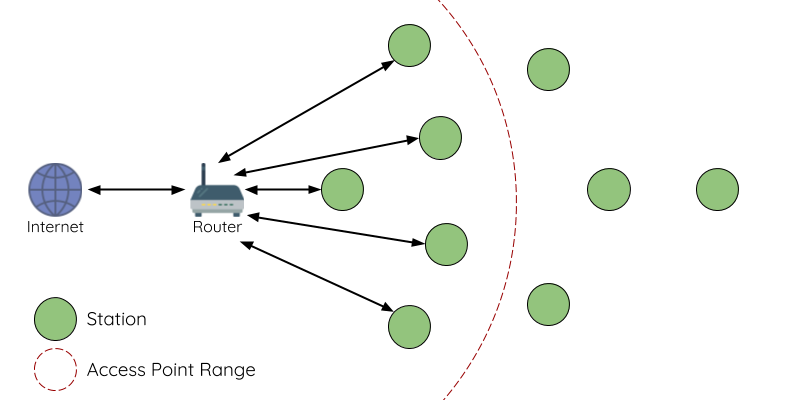Redes Mesh: mudanças entre as edições
De Wiki Cursos IFPR Foz
Ir para navegaçãoIr para pesquisar
(Criou página com '=Redes Mesh= As redes '''Redes Mesh''' são '''redes sem''' fio cujos nós tem a capacidade de se auto organizam, sem a necessidade de se conectarem a um ponto de acesso cent...') |
|||
| Linha 5: | Linha 5: | ||
==Redes WiFi x Redes Mesh == | ==Redes WiFi x Redes Mesh == | ||
A infraestrutura tradicional das redes WiFi é uma topologia estrela, na qual um nó central (ponto de acesso) conecta diretamente todas as outros nós | A infraestrutura tradicional das redes '''WiFi''' é uma topologia estrela, na qual um nó central ('''ponto de acesso''') conecta diretamente todas as outros nós ou estações. Os pontos de acesso são responsáveis por receber e encaminhar as transmissões entre as estações, assim como intermediar a comunicação com redes externas via um roteador. Uma desvantagem das redes WiFi é possuir uma área de cobertura limitada, que requer que cada estação se conecte diretamente com o ponto de acesso. Alem disto, quando aumenta o número de estações o ponto de acesso pode ficar sobrecarregado <ref name=WiFi-Mesh>Espressif, ESP-WIFI-MESH. https://docs.espressif.com/projects/esp-idf/en/latest/esp32/api-guides/esp-wifi-mesh.html</ref>. | ||
[[Arquivo: | The AP is responsible for arbitrating and forwarding transmissions between the stations. Some APs also relay transmissions to/from an external IP network via a router. Traditional infrastructure Wi-Fi networks suffer the disadvantage of limited coverage area due to the requirement that every station must be in range to directly connect with the AP. Furthermore, traditional Wi-Fi networks are susceptible to overloading as the maximum number of stations permitted in the network is limited by the capacity of the AP. | ||
[[Arquivo:mesh-traditional-network-architecture.png]] <ref name=WiFi-Mesh/> | |||
Edição das 19h13min de 10 de fevereiro de 2022
Redes Mesh
As redes Redes Mesh são redes sem fio cujos nós tem a capacidade de se auto organizam, sem a necessidade de se conectarem a um ponto de acesso central.
Redes WiFi x Redes Mesh
A infraestrutura tradicional das redes WiFi é uma topologia estrela, na qual um nó central (ponto de acesso) conecta diretamente todas as outros nós ou estações. Os pontos de acesso são responsáveis por receber e encaminhar as transmissões entre as estações, assim como intermediar a comunicação com redes externas via um roteador. Uma desvantagem das redes WiFi é possuir uma área de cobertura limitada, que requer que cada estação se conecte diretamente com o ponto de acesso. Alem disto, quando aumenta o número de estações o ponto de acesso pode ficar sobrecarregado [1].
The AP is responsible for arbitrating and forwarding transmissions between the stations. Some APs also relay transmissions to/from an external IP network via a router. Traditional infrastructure Wi-Fi networks suffer the disadvantage of limited coverage area due to the requirement that every station must be in range to directly connect with the AP. Furthermore, traditional Wi-Fi networks are susceptible to overloading as the maximum number of stations permitted in the network is limited by the capacity of the AP.
Referências
- ↑ 1,0 1,1 Espressif, ESP-WIFI-MESH. https://docs.espressif.com/projects/esp-idf/en/latest/esp32/api-guides/esp-wifi-mesh.html
